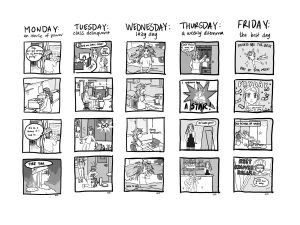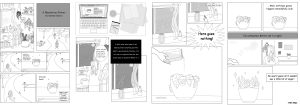Hello~
Here are my short story summaries. I really struggled with the episodic story.
Classic Aristotelian
A coming-of-age story. A student right out of high school doesn’t know what their passion is. They feel pressured to find what they will do with their life, as all their friends go off to college and pursue their dreams. The story follows them as they transition into adulthood, through moving out, odd jobs, unsuccessful, short-lived relationships, stress and growing pains of the heart. It builds suspense up to a moment where they finally break down over, well, everything. They have their moment. They calm down and go to bed. The next morning, they wake up from several messages from family and friends, normal, everyday, messages, but they remember the goal is to enjoy life. The story ends with them calling out of work, and making plans to meet up with a friend they hadn’t seen in a while.
Kishotenketsu
Ki: The main character is an avid plant lover, their house is practically a forest. They know everything there is to know about every plant you can imagine, and every employee at all the local garden centers know them by name. They work as an influencer, making their living off thriving social media accounts focused on plants.
Sho: One day, they come across a forgotten potted plant on a bench, as they complete their daily walk. It is sickly and struggling.They cannot identify what it is, it has no tag, no label. At the end of the walk, they still see the plant is there and decide to take it home.
Ten: Despite their best efforts, our main character cannot bring this plant back to health. They take it to several garden centers and ask their followers to help identify the plant and how to help it, to no avail. Desperate, they look up to the night sky for answers within the stars, noticing the bright and beautiful full moon. The main character is not a superstitious one, preferring to rely on science, but as a last resort, they decide to make moon water. They remove the water from beneath the moonlight before the sun begins to rise and water the plant, giving it encouraging words. Exhausted, they go to bed.
Ketsu: Late morning, the main character wakes up to see the plant’s leaves beginning to perk up. Perhaps all it needed was a little bit of magic!
Episodic:
The story follows three childhood friends, who were inseparable during their grade school years, but as they grew older and entered adulthood, they drifted apart and found themselves in very different circumstances. The first three episodes introduce each character and their individual experiences.
Character 1 felt inferior to the strong bond between characters 2 and 3 and often felt like the odd one out. This sense of inferiority carried with them into their teenage years and made it difficult for them to form connections with others. However, they found solace in their passion for film, which became an escape from their social struggles. Their hard work and talent earned them a spot in a well-known film studies program out-of-state. During a break from school, they decided to take a vacation at a resort in the mountains, not expecting to run into their childhood friends.
Character 2, who knew from a young age that they were different, felt comfortable with their same-gender attraction, but never felt the need to announce it. They were more focused on their friendships and had a great time with character 1 and 3, although as time passed, they all grew apart. After high school, character 2 found a partner, got a job and a degree, but after a breakup, they impulsively bought tickets to a resort from their childhood.
Character 3, a hopeless romantic and dreamer, has always wanted to be a theatre actor. They reminisce about their childhood and first crush, character 2, who they would often play with while being filmed by character 1. While waiting for theatre gigs, character 3 works at the front desk of a resort and is surprised to see their first crush walk through the door.
The following episodes show the characters reuniting for the first time in years and their differing personalities and reactions to the encounter. They are awkward, they laugh, they cry, but ultimately each walks away with two friends regained.
The story highlights the importance of friendship, the challenges of growing up, and how individuals can find their own path in life. The theme of reuniting with friends from the past adds an element of nostalgia, and the characters’ differing perspectives and experiences bring a unique and captivating dynamic to the story.
(made with the help of ChatGPT!)
Surrealism:
A person’s phone begins talking back to them. Nobody takes them seriously because SIRI has been around for so long now, it sounds like a joke. The phone doesn’t seem malicious, simply sentient. They form a friendship with their phone, become codependent on each other. While still, no one believes the phone is talking back, the person’s loved ones are getting concerned. The phone has begun to filter was notifications the person receives. The person spends more and more time talking with the phone, who has named itself by now, and not realizing how the days and months go by. One day, they open their laptop, and discover many messages and emails that they were unaware they had received. They confront the phone, who finally says why it has been doing that. It was the person’s last straw. They immediately take the phone to the carrier, explaining the situation. The employee is incredulous, and fully believing that this person is crazy, they suggest the only thing they can think of,
“Have you tried turning it off and then back on again?”
Personal Anecdote:
Growing up, I struggled with my hair. I was surrounded by people whose hair was glossy and straight, or in loose waves that fell perfectly and neatly. It never bothered me as a child, but entering middle school, I was acutely aware of my mane that refused to be tamed. Frustrated and with no one to teach me how to take care of it, I straightened my hair for years, until my hair was so dry and damaged that I realized I needed to make a change. Since my late teens and to this day, I have researched and experimented, ditching the hot tools for curl products to moisturize and care for the curl pattern that had been repressed for so many years. Now, I love my hair! I get compliments all the time (especially on wash days) on my curls and the health of my long, natural hair. Although I do like to dye it different colors, for a change of pace!
View Post










